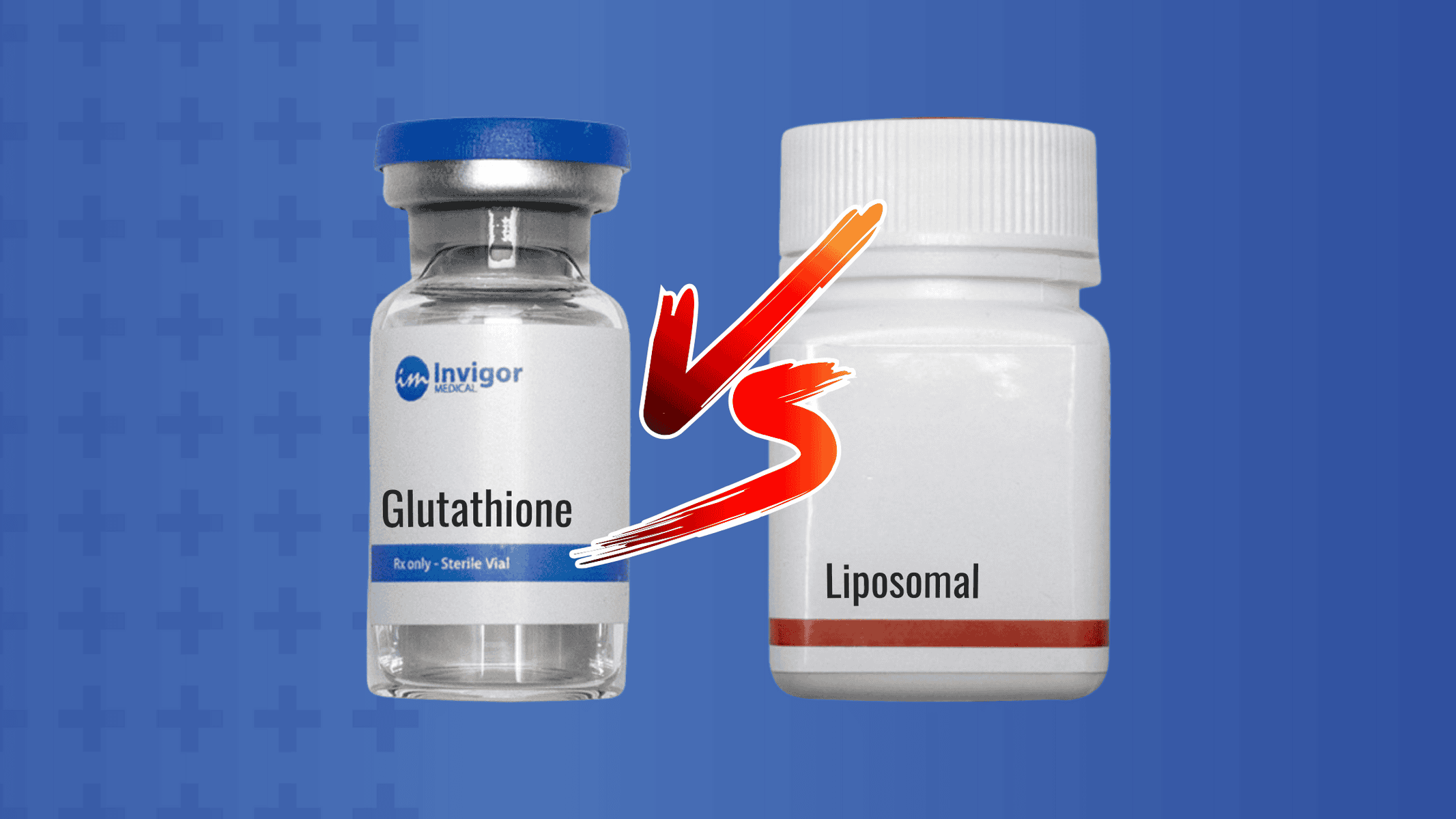When comparing glutathione vs liposomal glutathione, both treatments offer potential benefits for improving energy levels, supporting healthy aging, and enhancing overall wellness. While each form has its unique advantages, they both aim to boost antioxidant levels in the body, helping to reduce oxidative stress and promote a healthier, more vibrant lifestyle. Whether you’re considering glutathione for its potential detoxifying effects or liposomal glutathione for better absorption, both options can play a key role in supporting your health goals. To explore more about glutathione treatments, visit our Glutathione page.

Glutathione vs Liposomal Glutathione: What They Treat
What it Treats
- Supports detoxification and liver function
- Improves skin health and appearance
- Manages oxidative stress and free radical damage
- Enhances immune system function
- Supports cognitive health and reduces mental fatigue
- Enhances absorption for improved antioxidant effects
- Supports detoxification and liver health
- Reduces inflammation and promotes recovery
- Aids in managing chronic fatigue
- Improves skin health and elasticity
How it Works
Main Benefits
- Reduces oxidative stress and free radical damage
- Supports liver detoxification and function
- Enhances immune system response and function
- Alleviates symptoms of chronic fatigue and mental fog
- Improves skin health and reduces signs of aging
- Improves antioxidant absorption for enhanced cellular protection
- Supports detoxification, especially in liver and kidney function
- Reduces inflammation and promotes faster recovery from physical stress
- Controls oxidative damage linked to chronic conditions like diabetes
- Promotes healthy skin, enhancing elasticity and appearance
Glutathione vs Liposomal Glutathione: Dosing Requirements
Dosing Requirements
- Method of Administration: Glutathione is commonly administered through intravenous (IV) infusion or as an oral supplement.
- Typical Daily Dosage and Frequency: The typical daily dosage ranges from 500 mg to 1,000 mg, with infusions occurring once or twice a week, depending on individual needs.
- Optimal Timing: For oral supplements, it’s best to take glutathione on an empty stomach in the morning to maximize absorption.
- Common Medications or Supplements: Glutathione safely combines with vitamins C and E, as well as other antioxidants like N-acetyl cysteine (NAC).
- Method of Administration: Liposomal glutathione is primarily taken as an oral supplement in the form of capsules or liquid.
- Typical Daily Dosage and Frequency: The typical dosage is 250 mg to 500 mg per day, taken once or twice, depending on the individual’s health needs.
- Optimal Timing: It is most effective when taken in the morning or between meals to optimize absorption.
- Common Medications or Supplements: Liposomal glutathione can be safely taken with vitamin D, zinc, and other antioxidant-rich supplements.
Effect Duration
- Onset Time: Glutathione typically begins working within a few hours of intravenous infusion, while oral supplements may take longer to show effects, usually around 24–48 hours.
- Duration of Therapeutic Effects: The therapeutic effects of glutathione are often short-term, lasting for a few days after an infusion, but cumulative benefits can be seen with regular use.
- Immediate or Cumulative Effects: Glutathione’s effects are both immediate, especially with infusions, and cumulative when taken over time as an oral supplement.
- When to Expect Noticeable Results: Patients may notice improvements in energy levels and skin appearance within 1–2 weeks of regular treatments.
- Onset Time: Liposomal glutathione tends to have a slower onset compared to IV glutathione, with effects usually noticeable within 2–3 days of consistent oral use.
- Duration of Therapeutic Effects: The effects of liposomal glutathione can last longer than traditional glutathione due to its enhanced absorption, with sustained benefits over several weeks.
- Immediate or Cumulative Effects: Liposomal glutathione provides more cumulative benefits, with steady improvements in energy, detoxification, and skin health over time.
- When to Expect Noticeable Results: Results from liposomal glutathione may take about 1–3 weeks to become noticeable, particularly in energy levels and skin tone.
Safety and Side Effects: Glutathione vs Liposomal Glutathione
Side Effects and Safety
Common Side Effects:
- Mild headache
- Nausea
- Skin rashes
Rare Side Effects:
- Allergic reactions (swelling, difficulty breathing)
- Abdominal cramping
- Shortness of breath
Safety Summary: Glutathione is generally safe with few side effects, most of which are mild and temporary. Allergic reactions are rare but can be severe, requiring immediate medical attention. It is important to seek medical help if you experience any difficulty breathing or severe swelling.
Common Side Effects:
- Mild gastrointestinal discomfort
- Nausea
- Headache
Rare Side Effects:
- Allergic reactions (rash, itching)
- Diarrhea
- Fatigue
Safety Summary: Liposomal glutathione is well-tolerated, with most side effects being mild and transient. Serious side effects are rare, but if you experience allergic reactions like rash or difficulty breathing, seek medical attention immediately.
Drug Interactions: Both glutathione and liposomal glutathione can interact with certain medications, especially those that affect liver function or immune system modulation. Always consult with a healthcare provider before starting either treatment if you’re on other medications.
Ideal Candidates for Glutathione vs Liposomal Glutathione
Ideal Candidate
Glutathione is ideal for individuals seeking to improve detoxification, boost immune health, and manage oxidative stress.
- Adults aged 30–60 with liver function concerns or those undergoing detox treatments
- Individuals with chronic fatigue, brain fog, or weakened immune systems
- Patients with skin discoloration or aging signs seeking enhanced skin health
Liposomal glutathione is best for individuals looking for enhanced absorption and sustained antioxidant support over time.
- Adults aged 25–50 experiencing chronic inflammation or oxidative stress
- Individuals with skin aging concerns who need improved skin elasticity and glow
- Patients with conditions like diabetes or autoimmune diseases, where inflammation management is key
Glutathione vs Liposomal Glutathione: Which Is the Better Choice?
In comparing glutathione vs liposomal glutathione, the primary difference lies in the enhanced absorption offered by liposomal glutathione, making it more effective for sustained benefits over time. However, glutathione’s direct intravenous infusion provides faster, more immediate results, particularly for patients seeking rapid detoxification or immune support. Additionally, glutathione’s well-established use for skin health and liver detox makes it the optimal choice for those targeting these specific concerns. While liposomal glutathione remains a valuable option for gradual, long-term antioxidant support, glutathione is the preferred treatment for most patients seeking quicker, more targeted therapeutic effects.



